| Back to Back Issues Page |
 |
|
July 2018 Trail Bytes: Sweet Potato Pudding with Glazed Pecan Sauce July 05, 2018 |
| Hello, I recently heard about a marshmallow party that got out of hand. The incident started around a campfire where Scoutmaster Daniel was demonstrating how to toast a marshmallow to light-brown perfection. As he deftly dipped and turned his toasting stick in the fire, Daniel told his scouts the story about how the graham cracker got its name.
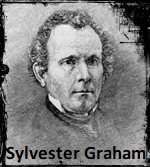
Originally called a digestive biscuit, the graham cracker is named after Sylvester Graham, a 19th century American preacher who came up during the temperance movement. Graham harped two main ideas – making bread at home using coarsely ground wheat, and living a lifestyle that minimized pleasure and stimulation of all kinds. All kinds meant sleeping on hard beds, avoiding warm baths, eating no meat, adding no spices, and drinking plain water. His message became a movement called Grahamism, and his people were known as Grahamites.
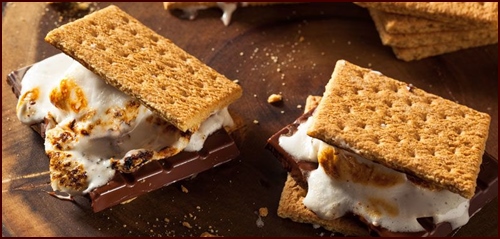 The act of putting gooey marshmallows and slabs of chocolate between two holy wheat crackers would have been sacrilegious to Sylvester Graham, but that was of no concern to the boys, who were waiting with sharpened sticks in hands for Scoutmaster Daniel to finish his story. It was then that Daniel made a crucial error. He let his marshmallow get too close to the coals.
The act of putting gooey marshmallows and slabs of chocolate between two holy wheat crackers would have been sacrilegious to Sylvester Graham, but that was of no concern to the boys, who were waiting with sharpened sticks in hands for Scoutmaster Daniel to finish his story. It was then that Daniel made a crucial error. He let his marshmallow get too close to the coals.
 A scout leader once told me, before I gave a cooking demonstration to a group of young scouts, that I needn’t worry about holding their attention. He said my topic was about two of the three things guaranteed to hold a boy’s interest – food and fire. Scoutmaster Daniel learned by accident that the third topic was weapons.
A scout leader once told me, before I gave a cooking demonstration to a group of young scouts, that I needn’t worry about holding their attention. He said my topic was about two of the three things guaranteed to hold a boy’s interest – food and fire. Scoutmaster Daniel learned by accident that the third topic was weapons.
In haste to save his marshmallow, Daniel whipped his stick out of the fire. A flaming nugget of gelatinized corn syrup flew through the air, landed in the woods amongst the pine needles, and set off a small blaze. Daniel and the other scout leaders ran over to extinguish the fire. There was a slight delay because nobody wanted a melted marshmallow stuck to the bottom of their boot. It was decided that the marshmallow would be doused with water.

Meanwhile, the boys back at the campfire could not resist acting upon the impression that had just been planted in their minds. Loading two or three marshmallows at a time, setting them aflame in the red coals, they launched their fiery rockets into the night sky.
No injuries were sustained, but a few mothers were nonetheless upset when their boys came home with charred marshmallow in their ears. As a small world would have it, one mother was a subscriber to Trail Bytes. She liked the idea, presented in last month’s newsletter, about making tortilla fruit tarts, which are tasty, but less likely to be hurled through the air. After reading that I intended to make tarts with sweet potato pudding, she asked if I could, please, come up with something other than marshmallows to melt over the sweet potatoes. While replacing marshmallows was no problem, a quick experiment revealed that keeping pudding in place within the confines of a crimped tortilla was a messy affair. It’s best to stick with the trusty spoon and bowl, or eat the pudding right out of the pot. In this issue of Trail Bytes, we’ll make a glazed pecan sauce to spoon over sweet potato pudding.
Sweet Potato Pudding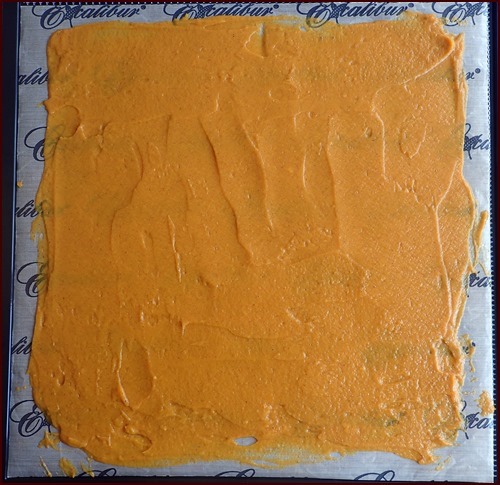 Sweet potato pudding is quick and easy to make on the trail by rehydrating sweet potato bark or powder. In Recipes for Adventure, you’ll learn how to make all kinds of bark, including sweet potato bark and pumpkin pie bark.
Sweet potato pudding is quick and easy to make on the trail by rehydrating sweet potato bark or powder. In Recipes for Adventure, you’ll learn how to make all kinds of bark, including sweet potato bark and pumpkin pie bark.
You can boil sweet potatoes to make bark, but I made this batch with baked sweet potatoes. More nutrients are retained by baking compared to boiling. Bake sweet potatoes on a cookie sheet for fifty minutes at 375° F (190° C). Place parchment paper under the potatoes to save yourself some scrubbing. After the potatoes have cooled, put one pound (453 grams) of chunked potatoes into a blender with half a cup of apple juice, one tablespoon of maple syrup, and one teaspoon of cinnamon. Blend until smooth. One pound of cooked sweet potatoes yields two cups blended mixture (473 ml). If using an Excalibur Dehydrator, one cup is the ideal quantity to spread thinly on each tray. Dehydrate at 135° F for eight to ten hours. For efficiency, double or triple the recipe to use as many trays as possible.
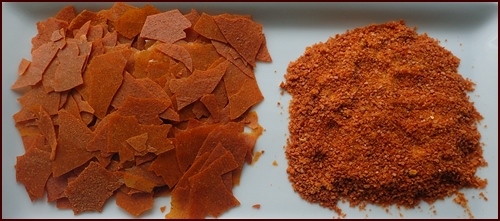 One cup of wet blended sweet potatoes yields ¾ cup bark, or ⅓ cup powder. Weight of either is 65 grams.
One cup of wet blended sweet potatoes yields ¾ cup bark, or ⅓ cup powder. Weight of either is 65 grams.
Dried sweet potato bark makes a chewy trail snack that’s loaded with nutrients. It reverts back into sweet potatoes with the addition of hot water. While not necessary, you can powder the dried bark by running it through a blender. Powdering reduces volume and slightly speeds up rehydration, but you lose the option of eating the bark as a chewy snack.
On the TrailHow to Make Sweet Potato PuddingServes 1 – 2 Combine ¾ cup bark, or ⅓ cup powder, with 1½ cups water. Gently heat while stirring continuously until pudding is hot. It will thicken within two minutes. Another way to prepare it is to pour boiled water over the bark or powder in a separate container.
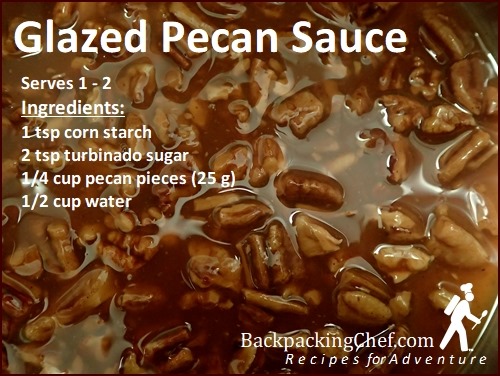 How to Make Glazed Pecan Sauce
How to Make Glazed Pecan Sauce
Serves 1 – 2 Combine one teaspoon of corn starch and two teaspoons of turbinado sugar with half a cup of cool water. Stir until corn starch dissolves. Do not add corn starch to hot water, because it will form clumps. Add a quarter cup of pecan pieces and light stove. Bring mixture to a light boil and let it bubble for a minute. It will thicken and turn a nice shade of brown. Logistics
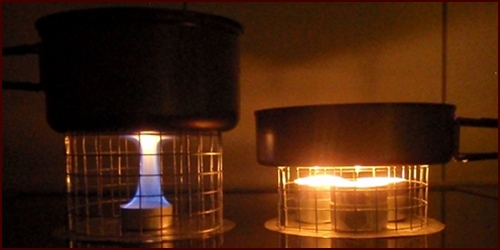
Evernew ECA 417 Pot with Fry Pan Lid
You can prepare the pudding and sauce at the same time if you have two sources of flame and two pots. An Evernew pot with fry pan lid is ideal for cooking two things at the same time. With this set-up, you would cook the pecan sauce in the fry pan lid over candles and the sweet potato pudding in the pot. Then you would spoon the pecan sauce over the sweet potato pudding and eat right from the pot. Read more about my alcohol stove and candle cooking techniques here.
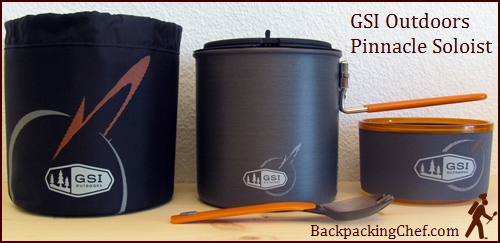
GSI Soloist and Dualist pots come with insulated cups and lids. In addition to the Soloist pot for one person, GSI makes a Dualist pot for two people. Both come with insulated cups and lids. With this set-up, the pudding could be made in the cup by adding boiled water to the bark or powder. While the pudding thickens, you would prepare the pecan sauce in the pot. To avoid clumping, start the sauce with cool or tepid water, not boiling hot water. A third option would be to prepare the pudding in a thermos food jar, if you carry one like I do.
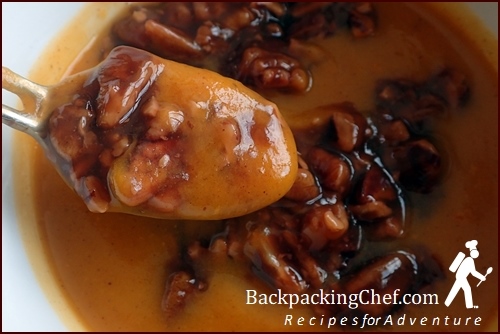 How was it?
How was it?
Amazing. I made several batches of the pecan sauce, adding cinnamon to one batch, and vanilla sugar to another. I like it best with just the turbinado sugar and nothing else. The sweet potato pudding already has a hint of cinnamon in it. I loved the way the pecans glistened on top of the pudding, and the soft, sweet crunch was perfect. Backpacking desserts should add pleasure to your adventures, and need not be as Spartan as Sylvester Graham would like. Forget the days of eating handfuls of granola. With a little effort, you can create memorable treats for yourself and your hiking partner. Make your trail friends jealous, or be kind, and give them a taste. See you next month with a report on our Great Glen Way hike in Scotland. We leave on July 22nd.
Freundliche Grüsse,
Chef Glenn & Dominique P.S. If you have any questions or comments about this issue of Trail Bytes, please reply to this email or use the contact form at BackpackingChef.com. This Sweet Potato Pudding recipe, and other ways to dehydrate and use sweet potatoes, are included in Recipes for Adventure II: The Best of Trail Bytes. 

If you received this newsletter from a friend and would like to subscribe (it's free), subscribe here. Visit my BackpackingChef Facebook page for the lastest posts. Be sure to "follow" the page to continue seeing posts. |
| Back to Back Issues Page |